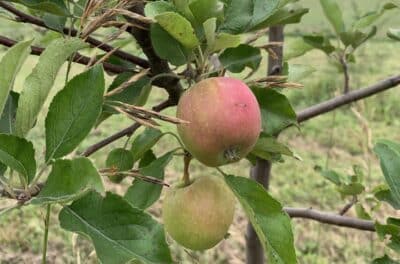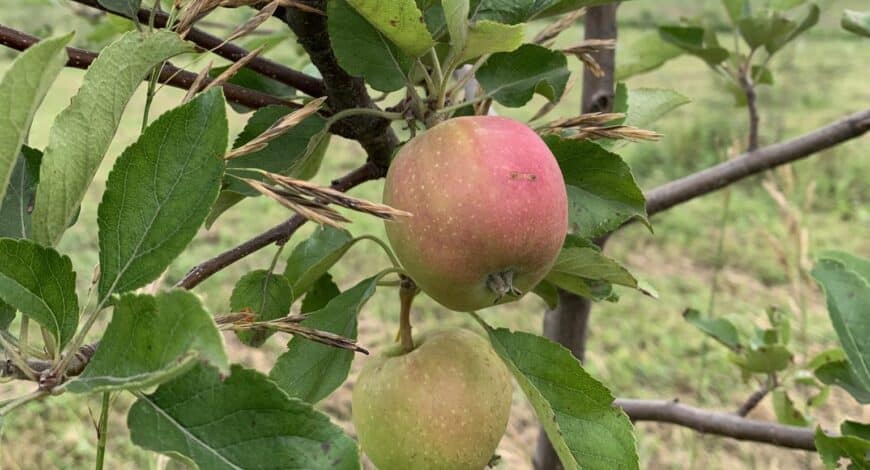
By Ben Kraus
You may have noticed there has been a lot more activity going on in the orchard this year. As the trees and vines mature, the increase in fruit set will attract the attention of both insects and fungi. We have been giving mother nature a hand.
The orchard and vineyard are cared for using the Integrated Pest Management (IPM) approach. IPM is an environmentally sensitive approach to pest management that considers the life cycles of pests and their interaction with the environment. This information is used to manage pest damage with the least possible hazard to people, property, and the environment. IPM for organic food production takes advantage of all appropriate pest management options, but limits the use of pesticides to those that are produced from natural sources, as opposed to synthetic chemicals.
There are four major insect pests that need to be monitored throughout the year. Plum curculio, codling moth, apple maggot, and Japanese beetles. The four major fungi include: Fire blight, apple scab, black rot, and sooty blotch & fly speck (SBFS). Traps are used to monitor insect pest populations and degree days are calculated using the Network for Environment and Weather Applications (NEWA). These tools help determine when intervention is necessary. Monitoring fungal pressures is more about what stage of growth the trees and vines are in, temperature, and the amount of and frequency at which it rains. NEWA is a great tool for monitoring these thresholds as well.
The products we use at Gwenyn Hill for fungi are preventative in nature. This means that we need to have the product applied on the tree or vine before it rains giving the plant a temporary shield against spores. Temporary to the point that every time the farm receives measurable rain or prolonged periods of hot sunny breezy days will warrant an application to restrengthen the shield. With the drought conditions this year, fungal issues have not been as prevalent in comparison with a “normal” growing season. Insects, however, are another story altogether. Mating disruption is implemented by hanging strips of plastic infused with pheromones to saturate the air so much that the two mating codling moths have a hard time finding each other. If you were driving by the orchard early last month you might have noticed the orchard looking a bit on the white side. That white you see is clay powder sprayed on the trees to irritate plum curculio beetles enough to keep them away from damaging newly forming fruit.
If further monitoring indicates that deterrent controls are not providing adequate protection, then an additional pest control method would be implemented. The orchard is not blanket-sprayed with a product that eradicates all living things. Each pest has its own product to help control populations. For example, a virus is sprayed for codling moth that just targets the larva as it is hatching. Once infected, the virus disrupts the larva’s digestive system enough to deter continued fruit consumption. The primary focus of a sound IPM plan is to avoid aggressive products to control pests.
Mother Nature has her own army of beneficial insects hard at work in the orchard. Because it has been so dry this year, the aphids had especially large populations—over the course of a month, beneficial insects like ladybugs have all but eradicated the aphids. The orchard has been bustling with activity this season with insects, fungi, and humans doing what needs to be done to keep each other in balance, working together to provide a bountiful harvest year after year.
Ben Kraus, Gwenyn Hill Farm’s Perennials Manager and IPM enthusiast, certainly thinks that watching apples ripen is far more interesting than watching paint dry.

